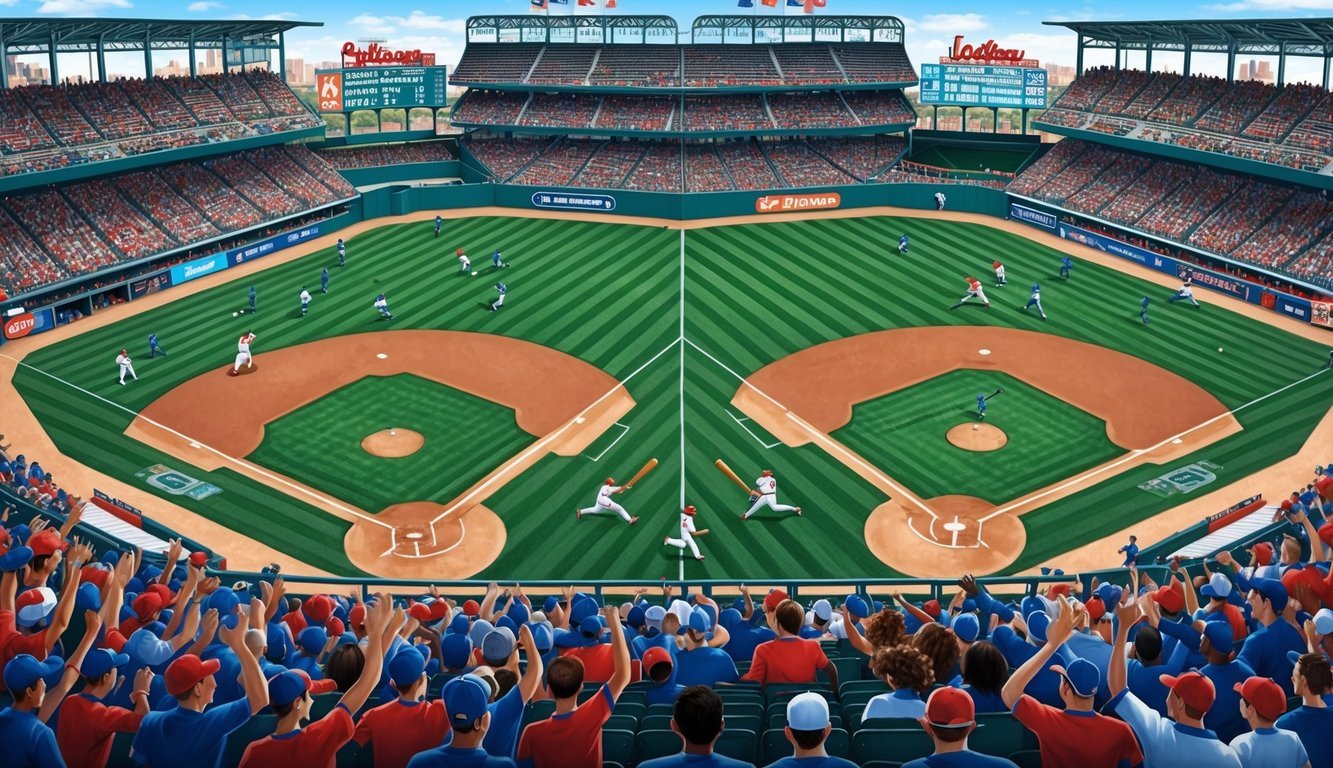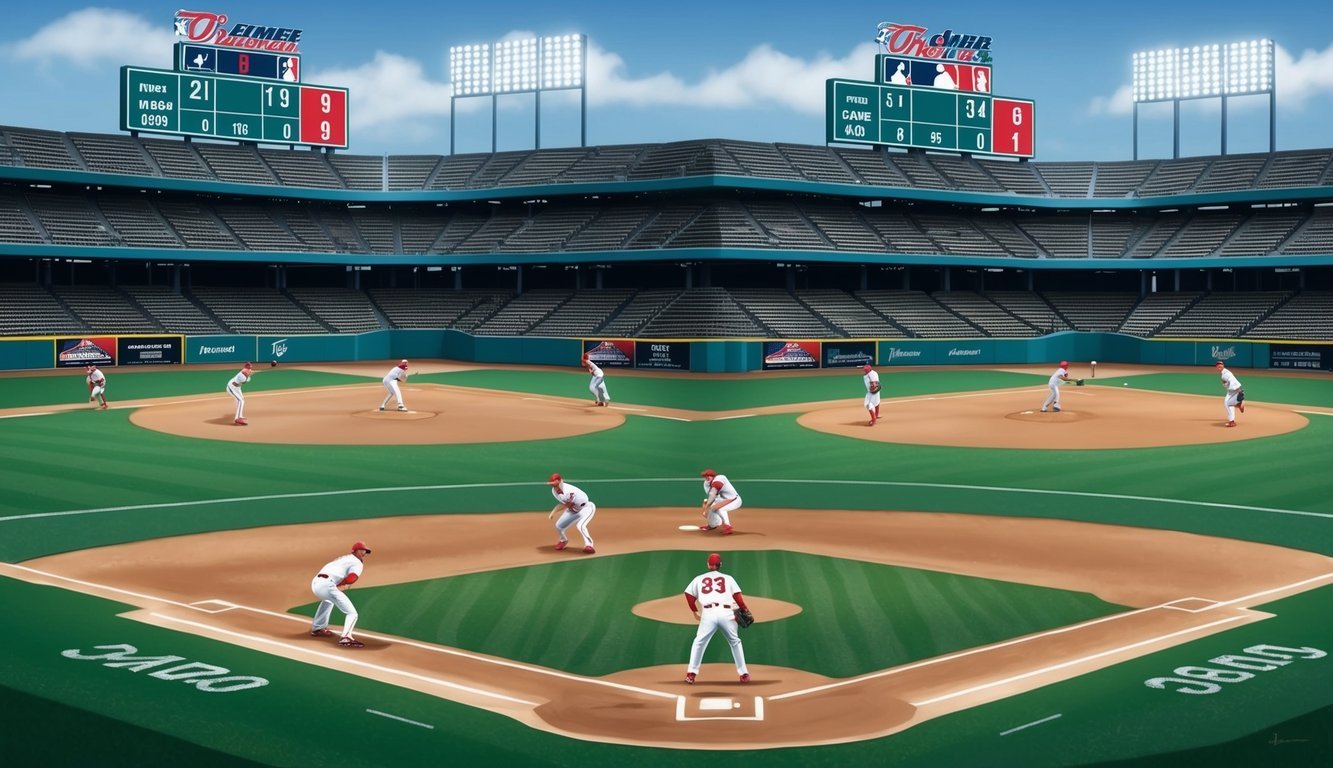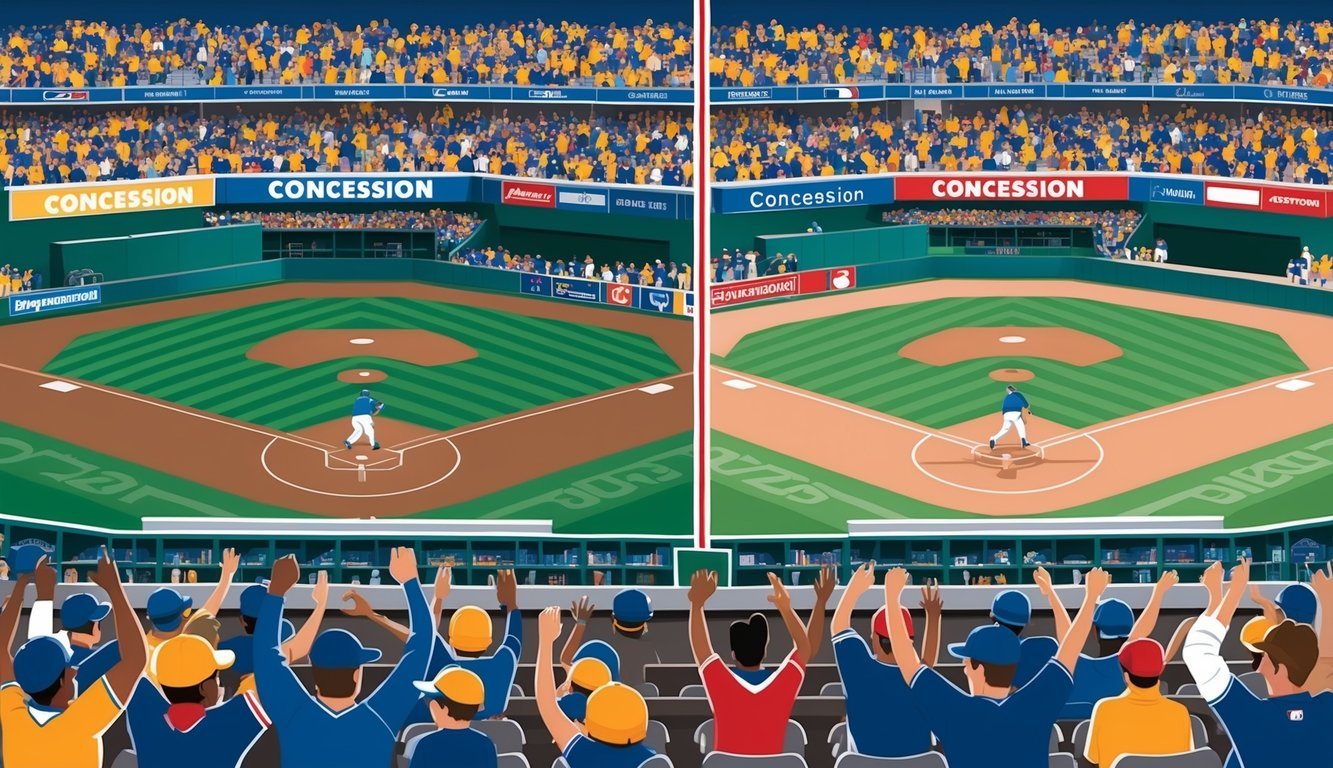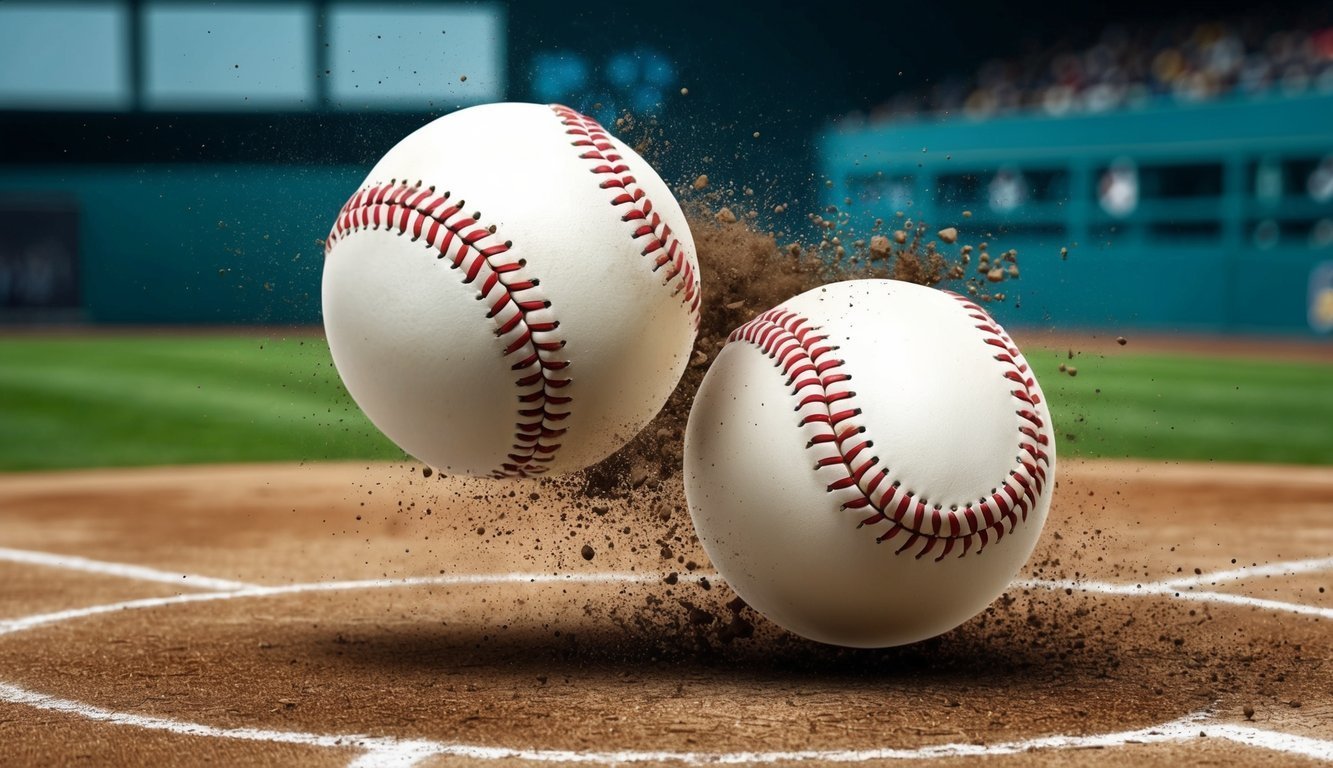Baseball fans love a good doubleheader – two games in one day between the same teams.
It’s a treat that harkens back to the sport’s earlier days.
In Major League Baseball, two games are played on the same date, often as a way to make up for previously postponed games.
Doubleheaders can take different forms.
Traditionally, they featured two games played back-to-back with a short break in between.
More recently, MLB has experimented with split doubleheaders where the games are separated by several hours.
This allows teams to sell separate tickets for each game and gives players more rest.
For die-hard fans, doubleheaders offer a full day of baseball action.
Teams must carefully manage their pitching rotations and lineups to handle the extra workload.
While less common than in the past, doubleheaders remain an exciting part of the MLB schedule that tests teams’ depth and endurance.
History of Doubleheaders in Baseball

Doubleheaders have been a cherished tradition in baseball for over a century.
These back-to-back games offer fans double the excitement and players twice the challenge.
Evolution from the Classic to Modern Doubleheader
Doubleheaders gained popularity in the 1880s, initially scheduled on holidays like Memorial Day and Independence Day.
Teams saw an opportunity to draw larger crowds and boost ticket sales.
The Chicago White Sox and other clubs embraced this format, often playing two games in a single day.
As baseball’s popularity grew, doubleheaders became more frequent.
During World War II, they reached their peak due to travel restrictions and player shortages.
Some pitchers, like Cliff Melton and Bobo Newsom, started an impressive 20 games in doubleheaders in a single season.
After the war, doubleheaders gradually declined.
By the late 1950s, they became less common.
Modern doubleheaders are often split, with separate admissions for each game, a shift from the traditional single-admission format.
Memorable Doubleheaders in MLB History
One of the most remarkable doubleheaders took place on July 4, 1939, between the Boston Red Sox and Philadelphia Athletics.
The teams combined for a staggering 54 runs in two games, setting a record that still stands.
The Brooklyn Bridegrooms (now Los Angeles Dodgers) played in the first-ever Sunday doubleheader in 1890.
This event helped pave the way for regular Sunday baseball games.
In 1973, the New York Mets and Pittsburgh Pirates played a memorable doubleheader that lasted over seven hours.
The marathon day of baseball kept fans on the edge of their seats until the final out.
Rules and Structure of Doubleheaders
Doubleheaders in baseball come with specific regulations and formats designed to accommodate multiple games in a single day.
These rules cover game length, scheduling practices, and various doubleheader types.
Seven Innings Rule
In 2020, Major League Baseball (MLB) introduced a temporary rule for doubleheaders, limiting games to seven innings instead of the standard nine.
This change aimed to reduce player fatigue and injury risk during compressed schedules.
The seven-inning format applies to both games of a doubleheader.
Extra innings still occur if the score is tied after seven, following regular extra-inning rules.
Some exceptions exist.
Suspended games that resume as part of a doubleheader may last the full nine innings.
Minor leagues and other levels of baseball may have different rules for doubleheader game length.
Scheduling and Rescheduling
Doubleheaders are often scheduled to make up postponed games due to weather or other unforeseen circumstances.
Teams and league officials work together to find suitable dates for these makeup games.
MLB typically avoids scheduling doubleheaders in advance.
When necessary, they prefer to schedule them on mutual off-days or by extending series.
Consecutive doubleheaders (playing doubleheaders on back-to-back days) are rare but can happen in extreme cases, like multiple postponements.
Teams are limited to 20 players on their active roster for doubleheaders, with an extra player allowed for the second game.
Types of Doubleheaders and Their Formats
Traditional doubleheaders feature two games played back-to-back with a short break in between.
Fans can attend both games with a single ticket.
Split doubleheaders involve two separate games with different start times.
The stadium is cleared between games, and separate tickets are required for each.
Day-night doubleheaders are a type of split doubleheader with one game in the afternoon and another in the evening.
This format allows teams to sell tickets separately for each game.
Home-and-home doubleheaders, though rare, involve the same two teams playing in different ballparks on the same day.
These usually occur in cities with two MLB teams.
Impact of Doubleheaders on Teams and Players

Doubleheaders present unique challenges and opportunities for baseball teams.
They test player stamina, strategic decision-making, and roster management skills.
Strategies and Management
Managers must carefully plan pitching rotations for doubleheaders.
They often use a spot starter or call up a minor league pitcher for one game.
Bullpen management becomes crucial.
Relievers may need to cover more innings across both games.
Teams sometimes employ the “double switch” tactic more frequently.
This allows them to change pitchers and adjust the batting order simultaneously.
By doing so, teams can not only improve their defensive matchups but also bring in a more strategic hitter to face a specific pitcher.
This is particularly advantageous when trying to leverage baseball hitting stick benefits, as it can enhance a player’s ability to capitalize on favorable matchups.
Additionally, the double switch ensures that the pinch hitter remains in the game while also keeping fresh arms on the mound, maximizing overall team performance.
Lineups often differ between games.
Managers may rest key players in one contest to keep them fresh for the other.
Player Endurance and Roster Changes
Doubleheaders can be physically demanding for players, especially catchers.
Many teams use different catchers for each game to prevent fatigue.
Position players might play both games but may switch positions to reduce strain.
Pitchers rarely start both games of a doubleheader.
Teams typically limit pitchers to one appearance per day.
The active roster often changes between games.
Teams may add a 26th player specifically for the doubleheader.
Recovery time becomes vital.
Players need to rehydrate and refuel quickly between games to maintain performance.
Doubleheaders in the Context of Covid-19
The Covid-19 pandemic brought significant changes to Major League Baseball’s doubleheader format and scheduling.
Teams faced new challenges in completing a full season while prioritizing player health and safety.
Adjustments to MLB Schedules
In 2020, MLB implemented seven-inning doubleheaders to reduce player exposure and manage a compressed schedule.
This allowed teams to make up postponed games more easily.
The league played 56 doubleheaders that season, the highest number since 1976.
The shortened games continued in 2021.
Teams could add a 27th player to their roster for doubleheaders.
This gave managers more flexibility with pitching rotations and player rest.
MLB returned to nine-inning doubleheaders in 2022.
Commissioner Rob Manfred viewed the seven-inning format as a temporary measure specific to the pandemic.
Safety Protocols and Adaptations
MLB introduced strict health protocols for the 2020 and 2021 seasons.
Players underwent frequent testing and followed social distancing guidelines in dugouts and clubhouses.
To reduce travel, teams often played multiple games against the same opponent in a single series.
This sometimes led to impromptu doubleheaders when games were postponed due to positive Covid-19 tests.
The league successfully completed both the 2020 and 2021 seasons, including postseasons.
Only two games were not made up in 2020, showcasing the effectiveness of the revised doubleheader format in managing the pandemic-impacted schedule.
Significance of Doubleheaders to Fans and Revenue

Doubleheaders offer unique opportunities for fans and teams alike.
They provide extended baseball action and potential financial benefits.
The Experience for Attendees
Doubleheaders give fans a full day of baseball excitement.
Two games for the price of one ticket is an attractive deal for many supporters.
Die-hard enthusiasts relish the chance to watch their favorite team play twice in one day.
The atmosphere at the ballpark during doubleheaders is often electric.
Fans settle in for a marathon of baseball, creating a festive mood.
Concession stands see increased activity as spectators stock up for the long haul.
Some doubleheaders attract different crowds for each game.
The first game might draw families and day-trippers, while the nightcap brings out night owls and after-work fans.
Economic Aspects and Ticket Sales
Doubleheaders can boost team revenues significantly.
They help teams recoup losses from rainouts or other postponed games.
Teams often see higher attendance for doubleheaders compared to single games.
Ticket pricing strategies vary for doubleheaders.
Some teams offer special combo deals, while others price the games separately.
This flexibility allows teams to maximize ticket sales and attract different customer segments.
Conventional doubleheaders, where one ticket grants entry to both games, are less common now.
Split doubleheaders, with separate admission for each game, have become more prevalent.
This change allows teams to potentially double their gate receipts.
Merchandise and concession sales typically increase during doubleheaders.
Fans spend more time at the ballpark, leading to higher per-capita spending on food, drinks, and souvenirs.
